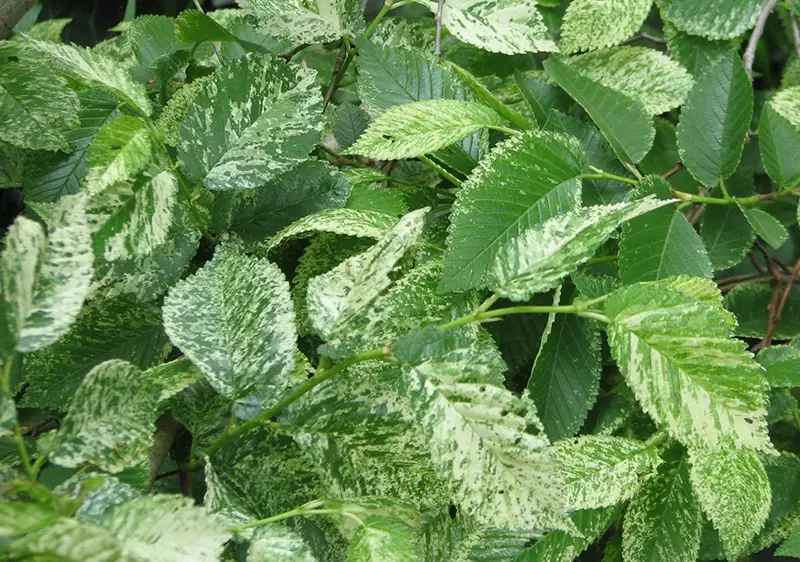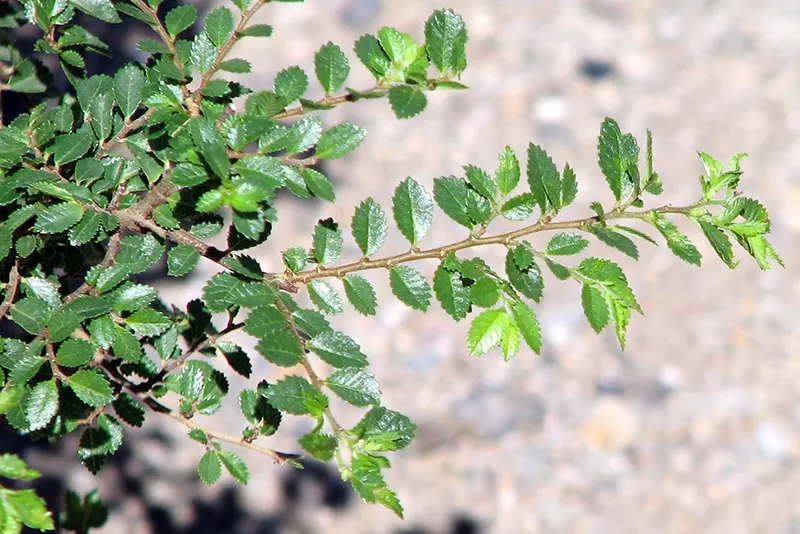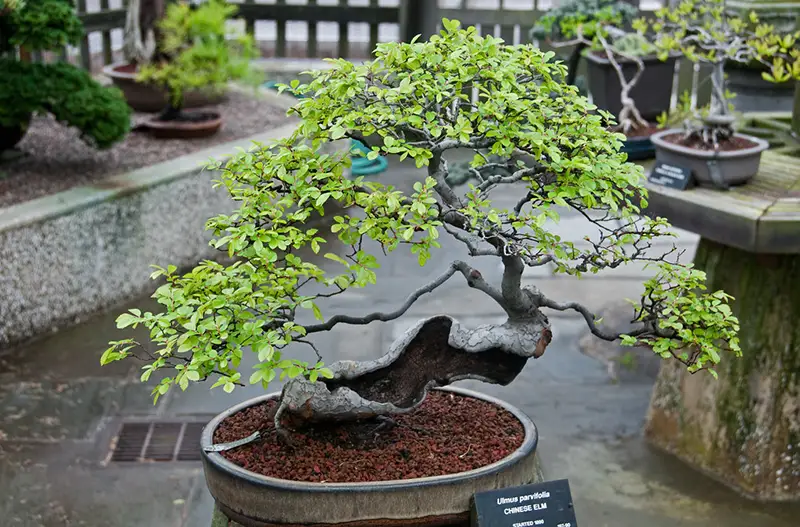Variegated Chinese Elm Care Sheet
Ulmus parvifolia
The Frosty Lacebark Elm is a beautiful tee with a stunning bark pattern and leaves. This Chinese elm is hardy and frost-resistant while having the potential to live as an evergreen all through the year if cared for correctly.
We’ll explain how you can care for the tree, the best watering frequency, and several other essential aspects you need to know when growing a Variegated Chinese Elm.
Image courtesy of Melburnian | License Details
Here's what you can find in our Variegated Chinese Elm bonsai tree species guide:
Here's what you can find in our Variegated Chinese Elm bonsai tree species guide:
01
02
03
04
05
Quick Variegated Chinese Elm Bonsai Care Sheet
Here’s a quick guide covering the most basic information you need to know when growing a Frosty Lacebark Chinese Elm Bonsai.
Recommended soil
A well-draining mix of soil.
Watering
Every two to three days. Soil must feel dry to the touch before watering.
Potting season
Repot every two years while the tree is growing. When older, only repot as needed.
Shaping and pruning season
Prune when necessary. Larger branches should be trimmed during late autumn.
Light
Can survive in full or partial light levels, making it suitable for indoors and outdoors placement.
Fertilizing
Fertilize often with a balanced mixture of solid and liquid options.
Propagation methods
Cuttings are the best method for propagation, however, seeds can work as well.
Pests and diseases
Scales are among the most common pests.
How to Care for Your Own Variegated Chinese Elm Bonsai
Caring for any bonsai can be complicated; here’s all the information you need to know about soil, watering, repotting, placement, propagation, and more for a Variegated Chinese Elm bonsai.
Best Soil
The best soil to use for your Frosty Lacebark Elm is any standard mix you can purchase for bonsai trees. As long as the soil is well-draining, the tree will thrive in it. This trait is necessary for this bonsai, as it quickly suffers from damage due to constantly wet roots.
Watering
During the warmer months, water your Frosty Lacebark Elm every two or three days, touching the soil to ensure it’s dry. If kept indoors, this frequency will likely be watering the tree every three days, regardless of the season.
However, if the tree is kept outdoors during winter, you’ll need to water your elm less. This aspect occurs when the Chinese elm enters a hibernation state when the temperature drops, requiring fewer nutrients each day.
Repotting
The Variegated Chinese Elm is a tree best repotted every two years while it’s young. Repotting while young will allow you to easily care for the roots, untangling them and pruning them as needed.
As the tree grows older, you’ll only need to prune it as you see fit. Often this will be judged by how healthy the tree is. Once you report it, ensure you thoroughly wash the pot out to remove any fungal or other diseases that the roots may have caused.
Shaping and Pruning
Shaping and pruning can be done year-round if the bonsai is kept indoors. If grown outdoors, shaping and pruning should be done between late spring and fall.
Location and Sunlight
The Variegated Chinese Elm is suitable for indoor or outdoor placement; however, it requires sufficient sunlight to survive. If kept indoors, the plant must be by a sun-facing window that receives a few hours of direct light per day.
If you choose to keep the tree outdoors, placing it in full or partial sunlight will keep it thriving. However, the more sun the tree receives, the more it will flourish, and the more frequently you’ll need to water it.
Fertilizing
When fertilizing your Frosty Lacebark Elm, the best method is to use a balanced mixture of solid and liquid parts. This balance will keep the tree growing and well nurtured. Use fertilizer often in spring and summer, but less during the cooler months.
Propagation Methods
Seeds are viable for propagating a Frosty Lacebark Elm; however, this method can pose many issues for beginners. The easiest way to propagate this elm is through cuttings, which will yield a new bonsai you can start growing with minimal effort.
Pests and Diseases
The Variegated Chinese Elm is often prone to infestation by scales and spider mites. Often, simply misting the plant with water will keep these pests away. However, if an infestation has occurred, use the right products to remove scales or spider mites without harming your tree.
Considerations for Growing an Indoor Variegated Chinese Elm
If you’re planning to grow the Variegated Chinese Elm indoors, here are two things you need to consider beforehand. These topics will help you determine the best location and why you want to bring the bonsai inside.
Placement
When placing the Variegated Chinese Elm indoors, you need to consider its sunlight requirements. The tree requires an average of five hours of sunlight per day to survive, with more light being preferred. As such, you’ll need a sun-facing window that receives the morning or afternoon sunlight.
If your placement doesn’t offer enough light, you’ll need to move it around through the day potentially. Constantly moving the tree is the main reason many grow a Frosty Lacebark Elm outside.
Temperature
While frost-resistant, the tree shouldn’t be left in a cold environment if you’re keeping it indoors. Room temperature is a good average to maintain throughout the year if you grow this tree indoors.
Common Issues When Caring For a Variegated Chinese Elm Bonsai
Here are the two most common issues you’ll face when caring for a Frosty Lacebark Elm. This tree is prone to overwatering as its roots are fragile. Incorrect soil choices or placement can lead to harming the tree.
Overwatering
The Chinese elms have delicate roots that can suffer quickly from being left moist for too long. This issue can often be seen too late as the damage occurs below the surface. However, if left unwatered for too long other issues can arise.
Check first with your finger if the soil is dry for the best results when watering. If the topsoil still feels moist, wait another day before watering.
Placement Decisions
With the correct placement indoors, the Chinese elm species become evergreen. However, when left outside, the tree still survives as it is hardy and partially frost resistant. As such, the placement of this tree often falls to preference.
However, if you keep the tree indoors, try to maintain room temperature to keep the tree happy and evergreen.
Image courtesy of Eric Kilby / License Details
FAQs about Variegated Chinese Elm Bonsai
Here are five of the most commonly asked questions you may have about the Frosty Lacebark or Chinese Elms in general. We’ll explain basic care needs, whether the Chinese elm is a suitable species to grow, and where you should place your Frosty Lacebark for optimal growth.
Chinese elms are great trees for both newcomers and seasoned growers. The tree is hardy and can survive a small amount of frost during winter. Additionally, the bonsai is indifferent to its location as long as its basic needs for light and water are met.
The Chinese elm is both an indoor and outdoor bonsai tree, growing equally well in either location. Indoors the plant may become evergreen if cared for well and kept in a suitable climate. Outdoors, the tree is resistant to frost but may suffer minor damage in the hot summer sun.
Growing a Chinese elm can take years. Bonsai grow at the same speed as a regular tree, often reaching their average growth height in 15 years. A Chinese elm bonsai can live for over a century and eventually grow past its average height.
Chinese elm bonsai prefers full sun exposure but can easily survive in partial sunlight. However, more sun will help the Chinese elm grow and thrive.
You should water a Variegated Chinese Elm bonsai once every two to three days. This frequency will allow your tree’s soil to drain, preventing any damage to the roots. If you’re ever unsure about watering, touch the soil and feel for any hint of moisture.







